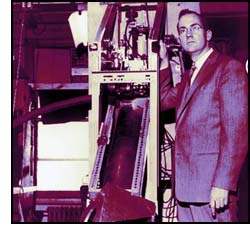
Stimulated emission, the basis of a laser beam, was first proposed in 1917, by Albert Einstein.
In 1954, American physicist Charles Townes created a device that amplified microwaves (an invisible form of radiation). The device was called a maser, because it was Microwave Amplification by Stimulated Emission of Radiation.
In 1960 American physicist Theodore Maiman built the first working laser with a ruby rod as the active medium, with a spiral lamp as the power source. Iranian-born American physicist Ali Javan built a helium-neon laser a year later. In 1966 a liquid laser was constructed by the American physicist Peter Sorokin.
At first the laser had a few uses, but it was often referred to by scientists as a ‘solution looking for a problem’. This opinion has changed today however, as lasers are amongst the most important pieces of technology in modern life.